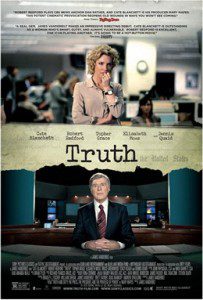Based on Interview with James Vanderbilt, Writer and Director of Truth
CBS made headlines last week when it turned down a multimillion dollar ad buy from Sony Pictures on behalf of the film “Truth,” the freshman directing effort by screenwriter James Vanderbilt.
That’s because “Truth” is based on a book of the same name by former 60 Minutes producer Mary Mapes. The story recounts (from her perspective) the events leading up to and following the disastrous “60 Minutes” report by famed CBS anchor Dan Rather claiming it had documentation showing President George W. Bush had received special treatment during his service in the National Guard. Further scrutiny found the documents were not adequately verified by CBS before Mapes and Rather took them on air. Experts denounced them as forgeries, leading to Rather’s exit from CBS and costing producer Mary Mapes her job.
It cost CBS some credibility at the time too, as many people at the network surely remember. In addition to rejecting the movie’s ad dollars, a CBS spokesman has called it “a disservice not just to the public but to journalists across the world.”
Shots fired. It’s been ten years now – long enough for us to look at the incident a little more objectively, says Vanderbilt – but denouncement of Mapes and Rather has begun again all the same. News websites are already alight with criticism, correcting the bent of the film for its seeming portrayal of the Mapes-Rather team (played by Cate Blanchett and Robert Redford, respectively) as victims of corporate forces looking out for the bottom line.
No doubt, this criticism provides a valuable part of the conversation. The journalistic consensus is that Mary Mapes screwed up in an epic case of shoddy reporting. “Truth,” however, draws first and foremost from Mapes’ book (in which she essentially spreads the blame around to everyone but herself), and Vanderbilt’s film adaptation explores the outcome and even the tone of the whole ordeal with more complexity. In the movie, the issue at stake isn’t so much whether or not Mapes was wrong. Instead, it dwells on the fact that she was a three-dimensional person operating at a pivotal moment in the news industry.

“I know people look at it as a political movie. I don’t necessarily think it is as much,” says Vanderbilt. “I had a great writing professor who said ‘If you want to send a message, call Western Union.’”
Story is king, goes the old adage, but that raises the question: Of all the stories out there, why bring “Truth” to the silver screen? Vanderbilt says he was drawn in out of good old-fashioned curiosity when he encountered Mapes story in a book excerpt in Vanity Fair not long after the controversy.
“I was struck by how much I didn’t know a story I thought I knew a lot about. Because I had followed this, like a lot of people did, when the piece first aired,” he says. As someone who grew up with Dan Rather as the face of CBS news, Vanderbilt sees this story as a critical moment in the digital transition that has rocked the journalism industry over the past decade. The old guard was giving way to a new frenzy of insane speed made possible by the Internet.
“I was born in 1975, and Dan Rather got the anchor chair in 1981, so basically from the time I was six years old to when this happened he was the face of CBS news,” he says. “To go from that period to where we are now where I have a little computer in my pocket that I can turn on and get ten thousand ways into the news, that’s an enormous shift. And (“Truth”) was a tipping point moment in it because it was the first time that the internet kind of rose up and affected a story in the way it did and with the speed that it did,” he says. “I think if you chart it, this is that moment. Clearly it leads to the downfall of one of those voices of God.”
Rather, who has praised the film, echoes this: “The core of it is about what’s happened to news reporting: Why it’s happened, how it’s happened, and why anybody should care about what’s happened in the news.”
Rather still argues that his team reported a true story in that infamous segment and says he doesn’t have any regrets about it. At one point he remarks in the film (similar to what he has said in real life) that his critics have missed the deeper thrust and underlying truth of the story – that the scandal over the forged documents has caused onlookers to miss the forest for a few rotten trees.
Put the nitpicking over details aside, and Rather may have a point, but that’s not how journalism works, and anyone with even the most basic knowledge of the news industry knows it. Journalism is a vehicle of facts, and while those facts can be twisted and presented in a way that skews the picture of what’s really going on, if you don’t at least get the facts right, then you get nothing right. The news is held to a high standard in this department, and rightfully so.
The purported story running underneath the facts, however, is fair game for the artist. Unlike journalists, the poets, authors, and filmmakers get to fudge, fictionalize, and rearrange the details in order to capture the deeper truths. This is what really makes “Truth” an intriguing subject. As a film (in contrast to being a news story), I found it quite enjoyable. Redford and Blanchett are in especially fine form, portraying characters that are largely empathetic. The news industry is tough on people, after all, and even when you do your job with aplomb it can chew you up. So when you screw up such a high-stakes story on national TV, sometimes you don’t get a second chance to do better next time.
“I always thought that my job first and foremost was to tell an interesting story, to put as many different viewpoints in the film as possible, and to not demonize anyone,” says Vanderbilt. “Everybody in the film is really just trying to do their jobs – just trying to get through this in one form or another. And they’re real people who are still walking around with real families. The movie’s going to come out and it’s going to have some effect on their lives.”
In this case the plurality of perspectives Vanderbilt worked into the film makes for an especially tricky proposition because Mapes, the protagonist toward which the audience is expected to show a healthy dose of sympathy, misled a lot of people and gave her employer a black eye. And so she ends up suspended in the middle of all of this somewhere along the spectrum between hero and villain, complete with her own professional aspirations, personal baggage, family to look after, and sources to protect.
“It was really important to me not to make anybody a mustache-twirling villain,” Vanderbilt says, “because A: That’s not how life works, and B: Nobody was a mustache-twirling villain.”
Critics from the right, of course, will say that every story has a message, and many are chalking “Truth” up to a piece of leftist Hollywood fare, prime evidence of the industry’s liberal bias. And maybe it is, even though Vanderbilt, for his part, seems pretty evenhanded. There is a deliberate, innate subjectivity to the film, and it’s a subjectivity that he welcomes.
“I spoke to a number of people who were not very pro-Mary or pro-Dan, and all of that I think is in the film,” he says. “It was important for me to put all of that in the film. I like movies that ask questions of the audience rather than give them clear-cut answers… What’s been really interesting is seeing people come out of the theater, and husbands and wives arguing: ‘Absolutely she should have been fired,’ and ‘How can you say that?’”
Indeed, Vanderbilt sees this lack of consensus as an attribute of the film. The freedom to have these sorts of debates, after all, is one of the beautiful things about democracy. The film’s title, “Truth,” suggests some sort of dogmatism at first glance, but it actually is indicative of just the opposite. The story doesn’t revolve around a central truth so much as it captures the futile attempts to pin down said truth. After all, Truth is the goal at the center of all journalism, but many extenuating factors affect that pursuit – the pressure of deadlines, sources that will or won’t talk, the ever-dwindling resources newsrooms have to invest in investigative journalism. And of course there’s the human element of reporters themselves. Dan Rather may have been a proverbial “voice of God” in his prime, but he’s fallible just like the rest of us.
And after all the dust has settled, there it remains, 10 years later, somewhere out there: the truth.
“It’s not easy to get to,” says Vanderbilt. “In this story in particular it’s incredibly elusive. It keeps changing… People lose their careers trying to get to it. They crash on the rocks. But it’s still an incredibly important thing to strive for.”










